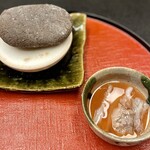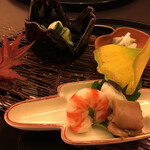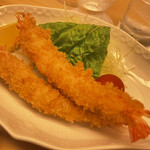
かが万
Kagaman ◆ かがまん
3.60
Osaka Station, Umeda, Shinchi
「Japanese Cuisine」
20,000-29,999円
5,000-5,999円
Opening hours: 11:30 to 14:00 (L.O. 13:30) 17:00 to 22:00 (L.O. 21:30)
Rest time: Sundays and national holidays (Closed from 12/29 to 1/4 for year-end and New Year holidays)
大阪府大阪市北区堂島1-2-33 坂ビル 1F
Photos
(20)




















Details
Reservation Info
Reservations are possible. Please feel free to contact us.
Children
Children are welcome.
Children are welcome. (*Only the counter is available for children under elementary school age.)
Payment Method
Credit cards accepted
(JCB, AMEX, VISA, Master, Diners)
Electronic money is not accepted
QR code payment is not available.
Restaurant Service Fee
Counter and table 10%, tatami room 15
This fee is charged by the restaurant, not related to our platform
Number of Seats
60 seats
(8 seats at counter, 20 seats at tables, 8 seats at tatami room, 28 seats at sunken kotatsu)
Private Dining Rooms
Yes
(2 persons available, 4 persons available, 6 persons available, 8 persons available, 10 to 20 persons available, 20 to 30 persons available)
Smoking and Non-Smoking
Smoking is not permitted at the counter. As the Law Concerning Measures Against Passive Smoking (Revised Health Promotion Law) has been in effect since April 1, 2020, please check with the restaurant before visiting as it may differ from the latest information.
Parking
None
Coin-operated parking available nearby
Facilities
Calm space, large seating area, counter seating, tatami room, sunken kotatsu, open terrace
Drink
Sake available, shochu available, wine available, stick to sake, stick to shochu, stick to wine
Dishes
Stick to vegetable dishes, fish dishes.
Comments
(21)
堺のまもちゃん
4.00
It had been a while since I had a meal in a new place. This time, I was invited to a year-end forget-the-year party and a social gathering. We started with appetizers, and in the middle, there was a container representing the zodiac sign for the year of the ox. Inside, there were marinated mackerel and raw horse mackerel. The presentation was elegant with pine leaves decorating the dish. We toasted with cold beer served in thin glass cups. The sashimi platter was beautifully arranged with tuna, squid, and sea bream. All fresh and delicious. The soup with shirako (milt) was delicate and flavorful. Next was a hot stone dish with shrimp and squid. We then switched to watered-down sweet potato shochu. Steamed rice with salmon roe was served, followed by grilled yellowtail collar, which was crispy and tasty. The meal continued with crab miso soup cooked in a crab shell, which was exquisite. The meal ended with a light and delicious whitebait porridge. Lastly, we enjoyed fruits and soft warabi mochi for dessert. It was a refined dining experience in a high-class establishment, which made me feel a bit uneasy, to be honest. Thank you for the wonderful meal!




Amy-yummy
4.30
From the room decor to the welcome and farewell, everything was set up perfectly for a wonderful experience. I have visited many times, and the timing of the dishes was just right. Whenever I want to enjoy Japanese cuisine in Osaka, this is the place I always want to go to.




しろくまのくま
4.00
Japanese cuisine at Kaga-Million is amazing. It is located inside a building, so you might expect a certain atmosphere, but once you enter the room, you are greeted with a unique and charming space reminiscent of a traditional Japanese house. The hospitality is top-notch, with the staff appearing and disappearing at just the right times, almost as if they have hidden cameras watching your every move! The food, especially the sukiyaki, is absolutely delicious.




Amy-yummy
4.30
If you want to eat kaiseki in Osaka, this is the place to go. In the Kagaman Building, there are different floors where you can choose from oden, tempura, sushi, and more depending on your mood. I prefer to enjoy kaiseki in a private room. From the appetizer to dessert, carefully selected ingredients and cooking methods are used to provide exquisite menus. Unlike high-end ryotei in Kyoto, this restaurant offers friendly service. You can enjoy top-notch flavors without any tension.




nickysunny
4.00
Kagamisan is a well-known high-end kaiseki restaurant that offers delicious dishes. Each dish is served in individual portions, allowing diners to choose their favorites without feeling overwhelmed. Although the prices are high, the quality of the food justifies it. The spacious tables make it a great choice for business entertaining.




小川 あおい
4.00
The luxurious comparison between the mythical crab and the Tajima crab was exquisite. Whether eaten as is or mixed with crab miso, both ways were delicious. The taste was incomparable to any crab I had ever eaten before. In addition, we also enjoyed sashimi, softshell turtle soup, and softshell turtle porridge.




ydental
4.30
I had the pleasure of visiting Kaga Man in Kitashinchi this time. I enjoyed a satisfying meal in a splendid private room. I indulged in seasonal dishes and received attentive service from a waitress dedicated to our room. Kaga Man has other affiliated restaurants serving oden, blowfish dishes, and more, which I would like to try as well. The owner, Mr. Saka, greeted us at the start of our meal and saw us off at the end. It was a memorable experience.




sushihime
3.80
Kitashinchi, Kagamanten is a restaurant I occasionally visit for lunch. Their deluxe white rice mixed with Chidori vinegar is delicious, with a fluffy texture and not too big of rice grains. The pickled ginger, mixed with Chidori vinegar and a vinegar called Daiya, has a mild flavor. You can choose to add salt or vinegar citrus to your liking. The marinated tuna appetizer and sushi are just as delicious as the bluefin tuna. The lunch set includes 1-2 appetizers, 12 pieces of sushi, hand rolls, and homemade mango ice cream, all for 4725 yen. It's reasonably priced and delicious, so I highly recommend it! They also have private rooms and a spacious atmosphere, making it convenient for business meetings or entertaining guests.




1181
4.00
The 2019 New Year's osechi cuisine is a single-tier order, but it comes at a quite high price. It includes various items such as black beans and tatsukuri, packed to the brim with luxuriousness. The seasoning is elegant, and if four people eat it, they will be full. There is nothing to complain about. If I had to say something, it would be the price, haha.


ひつじかい
4.00
Lately, I have had a lot of business in Kansai, and this time I came here. There is a parking lot underground right in front of this building, so it may be convenient for those with cars on rainy days (I'm not sure if it's a parking lot affiliated with the store). The elegant atmosphere of Kita-Shinchi suits a stylish older sister. Although I randomly think in Kansai dialect, "Ah, it's like Ginza, isn't it?" - it has a different cozy feel from Ginza, unique to Osaka. The entrance of the restaurant, adorned with an iron arrow, exudes tradition and elegance. Yet, it doesn't feel too formal. Upon entering the entrance, amidst the hustle and bustle of the greeting, a unique winter scent fills the air. As I look around near the entrance, I notice a brazier with hot charcoal burning. "Ah, it's already December, I had forgotten," it reminds me of the season. The scent of incense follows me, transitioning my mood to a different world from the hustle and bustle outside Shinchi. Whether it was two types of incense or a mix with the charcoal scent, as I advance, the scent changes again, and as I step inside the entrance and climb to the second floor, with each step, my mood shifts distinctly. "Wow, this place really knows hospitality," I think in Kansai dialect again (laughs). Guided through a corridor lined with tatami mats to a private room on the second floor (again, a spacious and tasteful room), I was impressed that the incense did not permeate the room, maintaining the welcoming atmosphere only at the entrance. As a dessert reviewer, I won't go into detail about the course dishes since others have already reviewed them extensively, but the course dishes were indeed delicious. The presentation and the dishes were impressive. The fillet cooked in an iron pot? was tender and tasty. Perhaps it was Noto beef. The sashimi was fresh and had a nice texture. The yuba ankake was also delicious. (Since the iron pot was hot, when you are spoken to, it's best to eat the meat quickly to prevent it from overcooking. I burned a piece due to this (laughs)). When it comes to the crab, the staff will help you extract the meat (I prefer to do it myself, so I remained silent and diligently extracted it myself). The customary towel exchange after the crab is a classic service. Now, as the dessert specialist, here is my review (laughs). Towards the end of the course, a dish of Japanese pear, persimmon, pomegranate, and others was served, and I thought it was the end, but then a bowl of sweet red bean soup appeared. Small pieces of mochi were floating in a thick red bean paste, almost like "anko," and I had a feeling that these small mochi were also seared on the brazier I saw at the entrance earlier. The connection between the entrance of the restaurant and the dishes, where the beginning and the end were properly linked, impressed me, as it is customary for the host to thank the master of the house. The person I was dining with also sighed in delight, saying how delicious this sweet red bean soup was. I thought that normal Japanese tea would be served after this, but to my surprise, a well-prepared bowl of matcha was brought out! "Ah, so they finish with matcha," I was amazed. Each guest is served a different grilled dish with their matcha. Since there were no comments on matcha in other reviews, I'm adding this in, but literally, this kaiseki meal, where every luxury was poured into the dishes, was meant for us to savor this final cup of tea together, reflecting on the essence of this restaurant's name "Kagamane" and the culture of Maeda Toshiie, the lord of the Kaga domain, and to experience the essence of this restaurant and the heart of the owner.

しぽぽ728
4.30
I was taken to the delicious Japanese restaurant Kaga-Ma by a friend to celebrate in Kitashinchi. We enjoyed a luxurious kaiseki course in a calm and lovely atmosphere from lunchtime. Every dish was incredibly delicious! I was especially happy to receive a special gift of red rice in a tai-shaped container. Thank you for the wonderful meal!




Amy-yummy
4.40
The New Year's menu at the long-established restaurant Kagaman was truly beautiful ❤️ The dishes were exquisite, with some even inspired by the zodiac signs. It is a wonderful restaurant for a sunny day!




ayumi323531
3.70
The dishes were abundant in the taste of autumn, and Japanese cuisine always brings a sense of calmness. The balanced course meal, ending with matcha, was truly exceptional. The matsutake mushroom was incredibly delicious. It was the perfect time in a private room to relax and enjoy.




BayaTube
4.00
It is a classy and delicious famous restaurant. The head chef, as well as the hostess and staff, are attentive and thoughtful, allowing you to enjoy a luxurious time.




お食事記録
4.20
I visited on Christmas Eve. The sake and Japanese food are always delicious whenever I visit. The clay pot rice is my favorite.




kume3573
4.00
This time, I enjoyed matsutake mushrooms and fugu. They were very delicious.




小川 あおい
3.90
I enjoyed both crab and softshell turtle luxuriously. It was delicious.




おさきりほ
4.00
I used it for reception. The landlady who understood that they were foreigners and skimped on explaining the food, even though I was there as an interpreter~w The food was delicious. The recommended sake was also delicious.




kemt3
3.50


yukinco7292
3.90




みんみ。
0.00



Email Login